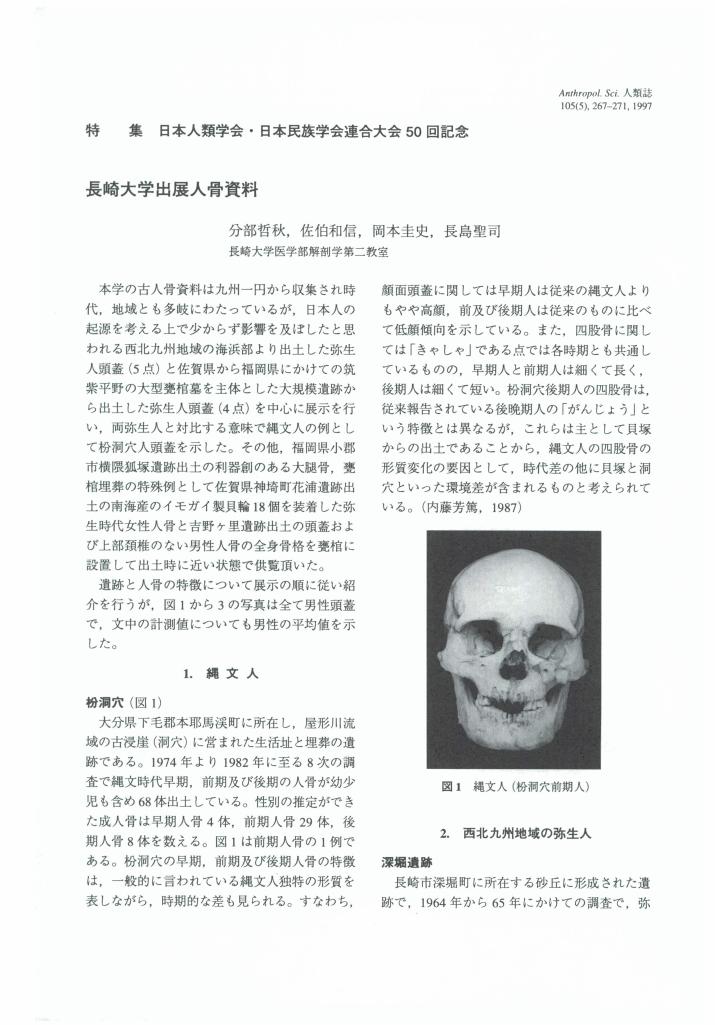3 0 0 0 OA 日本人の起源: 分子人類学の立場から
- 著者
- 尾本 恵市
- 出版者
- 一班社団法人 日本人類学会
- 雑誌
- Anthropological Science (ISSN:09187960)
- 巻号頁・発行日
- vol.103, no.5, pp.415-427, 1995 (Released:2008-02-26)
- 参考文献数
- 47
この総説は, 日本人の起源の問題について, 分子人類学の立場から, 何が, どこまでいえるのかを紹介し, 今後の総合的な日本人研究への一助とする目的で書かれた。検討のための土台として, 埴原の「二重構造モデル」が用いられた。このモデルを, (1)「原日本人」は東南アジア起源である, (2) 現代日本人の諸集団の形成には、「原日本人」と北東アジア系の渡来人という主として2つの系統を異にする集団が関わっている, との2つの部分仮説にわけ, それぞれを個別に検討した。分子人類学的に重要な資料としては, 古人骨のミトコンドリアDNAの塩基配列 (宝来ら) と古典的遺伝標識の遺伝子頻度を用いた多変量解析 (根井, および筆者ら) などがある。前者は, 原日本人の南方起源説にとり有利な資料を, また, 後者は, 反対に, 原日本人の北方起源説を支持する資料を提供している。また, 埴原のいう「二重構造」の存在についても, 意見がわかれている。このような不一致点をどのように説明するかが, 大きな問題である。本論文で筆者は, 問題点の所在を明らかにすると共に, 将来の検討に対する資料として, いくつかの提案をした。
2 0 0 0 OA 北海道の古人骨における齲歯頻度の時代的推移
- 著者
- 大島 直行
- 出版者
- 一班社団法人 日本人類学会
- 雑誌
- Anthropological Science (ISSN:09187960)
- 巻号頁・発行日
- vol.104, no.5, pp.385-397, 1996 (Released:2008-02-26)
- 参考文献数
- 101
- 被引用文献数
- 2 1
北海道における縄文時代から近代に至るまでの古人骨資料を用いて, 各時代の成人集団における齲歯頻度の時代的推移を調査した。縄文時代から続縄文時代になると齲歯頻度は有意に低下し, その後, 近世アイヌに至るまで齲歯は少ないまま推移する。また, オホーツク文化の人々には齲歯が見られなかったが, これは, 海産動物を中心とする動物質食への依存が強いことと関係が深いと思われる。縄文時代においては, 北海道北東部は南西部に比べ齲歯頻度が低いが, 本州の縄文時代人と比較すると北海道南西部でもはるかにその頻度が低い。これも, 縄文時代の北海道, とくに北東部では本州に比べ, 食料を海産動物に頼る割合がもともと高かったことが原因と考えられる。ただし, 本州においても, 齲歯頻度が極端に低い縄文時代人集団があり, 齲歯の成因として植物食料の量のみならず, その加工技術, 集団全体の栄養状態なども考慮する必要があると思われる。
1 0 0 0 Exploring models of human migration to the Japanese archipelago using genome-wide genetic data
- 著者
- OSADA NAOKI KAWAI YOSUKE
- 出版者
- 一班社団法人 日本人類学会
- 雑誌
- Anthropological Science (ISSN:09187960)
- 巻号頁・発行日
- vol.129, no.1, pp.45-58, 2021
- 被引用文献数
- 8
<p>The origins of people in the Japanese archipelago are of long-standing interest among anthropologists, archeologists, linguists, and historians studying the history of Japan. While the 'dual-structure' model proposed by Hanihara in 1991 has been considered the primary working hypothesis for three decades, recent advances in DNA typing and sequencing technologies provide an unprecedented amount of present-day and ancient human nuclear genome data, which enable us to refine or extend the dual-structure model. In this review, we summarize recent genome sequencing efforts of present-day and ancient people in Asia, mostly focusing on East Asia, and we discuss the possible migration routes and admixture patterns of Japanese ancestors. We also report on a meta-analysis we performed by compiling publicly available datasets to clarify the genetic relationships of present-day and ancient Japanese populations with surrounding populations. Because the ancient genetic data from the Japanese archipelago have not yet been fully analyzed, we have to corroborate models of prehistoric human movement using not only new genetic data but also linguistic and archeological data to reconstruct a more comprehensive history of the Japanese people.</p>
1 0 0 0 OA 長崎大学出展人骨資料
- 著者
- 分部 哲秋 佐伯 和信 岡本 圭史 長島 聖司
- 出版者
- 一班社団法人 日本人類学会
- 雑誌
- Anthropological Science (ISSN:09187960)
- 巻号頁・発行日
- vol.105, no.5, pp.267-271, 1997 (Released:2010-10-21)
- 参考文献数
- 11
